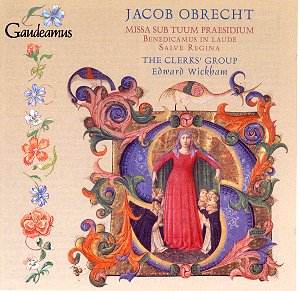It seems odd that this
Mass, perhaps the most untypical and
undatable of Obrecht’s approximately
thirty published masses should be one
of the best known and often performed.
It is in many ways a tough nut to crack
for performers and listeners but not
as tough as the amazing compositional
tour-de-force which the composer set
himself.
I can recall a recording
in the late 1960s on Archiv by Konrad
Ruhland (I’m afraid I cannot recall
any other details) which was coupled
with the completely contrasting ‘Missa
Mi-Mi’ of Ockeghem. The Obrecht was
a shock in that it was the first time
that I had come across a mass with the
plainchant unchanged in the top part
(Descantus 1) throughout and which sang,
not the Mass text, but the motet text.
Secondly this version had curious instrumental
doubling of the top part making it ring
out in a powerful but expressionless
manner.
Oddly enough I have
just read a review in the November 2003
‘Gramophone’ of a new recording of this
Mass (which I have not yet heard) by
Ars Nova under Paul Hillier (Van CDO2),
coupled with several of Obrecht’s’ Marian
motets. So, after thirty years, two
versions appear almost simultaneously.
The Clerks group has
already made a tremendous impression
in this repertoire with the complete
works of Ockeghem, much Josquin and
discs of Barbereau and Pierre de la
Rue as well as an earlier Obrecht. Sometimes
their tempi and general flavour can
be a little rushed and lacking in subtlety.
More importantly in this disc the acoustic
of the church of St. Andrew’s, West
Wratting, comes across as having little
resonance and atmosphere. Disappointingly,
this makes these recordings more studio
sounding than is appropriate.
To give some idea of
the music’s compositional background
I think Rob Wegman in his ‘Born for
the Muses’ (Clarendon Press OUP 1994)
is quite right when he says that in
this Mass Obrecht "was Architect
first, musician second". I will
quote further from his book. "The
Mass consists of 888 semibreves, the
Kyrie and Gloria have 333 the rest come
to 555". The form is: Kyrie in
three parts, Gloria in four, Credo (which
also includes the plainchant ‘Audi nos’
in Descantus II) in five and Sanctus
in six parts now including the plainchant
‘Mediatrix nostra’. The seven-part Agnus
1 and 2 include the chant ‘Celsus nuntiat
Gabriel’ and culminate in "the
Agnus 3 which now has four pre-existent
chant melodies, one being the ‘Sub Tuum’
of course still in the top, whilst the
other three parts freely rhythmize".
Why these particular plainchant texts?
They are all Marian-related, and a look
at the CD cover will explain, as the
writer of the notes Edward Wickham points
out, that the Virgin is shown massively
towering above the heads of the ordinary
mortals below with out-folded wings
over the top of them. This is the function
then of the ‘Sub Tuum’ plainchant: always
above the other voices which gradually,
with the use of additional texts, enunciate
even more praise in her honour.
Does all this make
a worthwhile piece of music? Well I
have to say that I’m not sure. This
is not my favourite Obrecht Mass. I
prefer him when he is really free and
fantasises around melodies as in the
wonderful and huge ‘Missa Maria Zart’.
(Tallis Scholars on Gimell 0132). Yet
this is no reflection on the performers
who carry all before them and seem convinced
by the music’s quality.
One may wonder why
Obrecht does not find himself performed
in anything other than concerts or on
disc, whereas Josquin and to a lesser
extent some works of Ockeghem have found
their way into the liturgy. Part of
the problem is his very complex counterpoint.
Another problem might be his chosen
texts. The CD closes with ‘Factor Orbis’
a fine but complex work which exemplifies
these problems. Edward Wickham describes
it as "a joyful and sometimes meditative
musical collage of Advent Chants and
texts, matched only in sophistication
by Obrecht’s Mass". He goes on
"repeated listening will reveal
an intricate web of textual polyphony".
There is little chance of a modern choir
singing such music other than a specialist
one. The same surely applies to the
mellifluous ‘Salve Regina’. Two settings
recorded by Jeremy Summerly on Naxos
(8.553210) with the Oxford Camerata,
are at least in four and six parts respectively.
However this lengthy version is in just
three and tuning is difficult in many
places; superbly managed here, of course.
‘Mille Quingentis’ probably commemorates
the death of Obrecht’s father but also
quotes Josquin’s famous ‘Ave Maria’.
This music is most unlikely to come
your way again. The ‘Salve crux’ has
been recorded before but at a much slower
tempo and at an even lower pitch. (The
Dufay Consort/Gary Cooper Dervoguilla
CD102). It is a motet for the ‘Finding
of the Cross’, hardly a subject for
modern liturgies although some Roman
Catholic establishments might well like
to look at it. Being for men’s voices
and over ten minutes in length it is
unlikely to appeal.
The Clerks’ Group is
at present the best companion in this
repertoire. That said, I never feel
totally convinced by them; I would like
more flamboyance and passion in the
performances which are often rather
chaste. I would suggest anyway that
this disc would not be the best place
to start with this composer. Try instead
the Clerks’ Group recording of the ‘Missa
Malheur me Bat’ (ASV GAU 171) which
includes motets by the little known
Johannes Martini.
For all that, it is
a wonderful thing that here we have
a totally professional and committed
group who have more or less consistently
the same personnel from disc to disc
and who are giving us beautiful and
thoughtful renderings of music which
otherwise would remain on dusty shelves.
Gary Higginson

